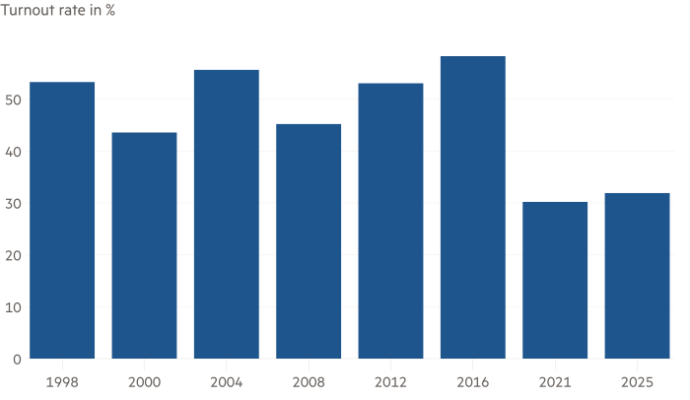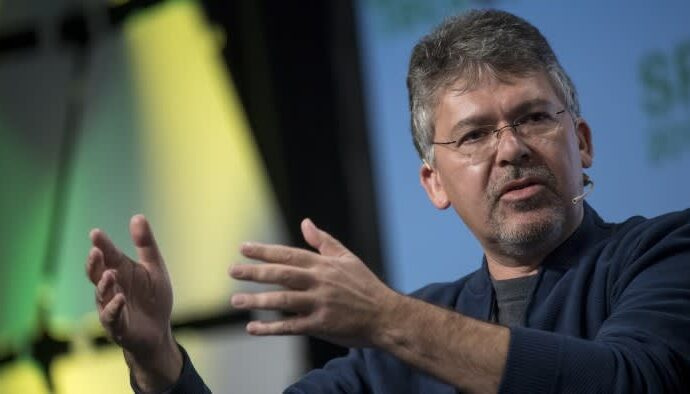Unlock the Editor’s Digest for free
Roula Khalaf, Editor of the FT, selects her favourite stories in this weekly newsletter.
Japan’s parliament has elected Sanae Takaichi as the country’s first female prime minister, as Tokyo stocks hit a record high on investor optimism over her government’s policies.
Takaichi won 237 votes from MPs in the 465-seat lower house on Tuesday following a breakthrough coalition deal by her Liberal Democratic party 24 hours earlier.
Her first act as prime minister was to appoint a cabinet that included the country’s first female finance minister and, in a move aimed at unifying a divided party, three of the four politicians who ran against her in the party’s internal leadership race earlier this month.
Takaichi’s new ruling coalition is expected to consider an increase in defence spending, tax cuts and a push to restart Japan’s suspended nuclear power plants.
The benchmark Nikkei 225 Average on Tuesday closed 0.3 per cent higher, having surged as much as 1.5 per cent during trading to more than 49,900 points, within striking distance of a landmark 50,000 level. The index is up more than 25 per cent this year.
At a press conference later on Tuesday, the new prime minister warned that she was starting the job with the nation in a state of crisis, with households suffering the effects of rising prices and “no time to stand still”.
She dismissed speculation she might hold a snap general election, saying she would order officials to produce an economic stimulus package to address the rising cost of living.
“Our first priority is economic. I have no time to discuss the dissolution of the house,” she said.
Takaichi, a former TV presenter and an admirer of Margaret Thatcher, named Satsuki Katayama, a former economic revitalisation minister, as the new finance minister.
Other cabinet appointments include Yoshimasa Hayashi as minister of internal affairs and communications, Toshimitsu Motegi as foreign minister and Shinjiro Koizumi as defence minister. All three stood against Takaichi for LDP leadership and represent the more liberal wing of the party.
Takaichi and Katayama’s first big international test comes next week, with US President Donald Trump and US Treasury secretary Scott Bessent expected to visit Tokyo ahead of an Asia Pacific Economic Cooperation Forum summit in South Korea.
The yen continued to trade weakly against the US dollar, dropping below the ¥151 level on bets that the Bank of Japan may delay raising interest rates at next week’s policy meeting.
The stock market enthusiasm followed Monday’s signing of a coalition agreement between the LDP, which has ruled Japan for most of the past 70 years, and the 15-year-old reformist Japan Innovation party, which has seized a significant number of parliamentary seats around Osaka.
Hirofumi Yoshimura, the governor of Osaka and co-head of the JIP, said after the parliamentary vote that “Prime Minister Takaichi’s fervent desire to genuinely improve Japan came across very clearly . . . We are not halfhearted in our approach, and this shared conviction has brought us together.”
The formation of the LDP-JIP coalition followed the collapse this month of the LDP’s 26-year coalition with the Komeito party. Komeito shared many policy goals with the LDP but often acted as a brake on major initiatives.
Mieko Nakabayashi, a political scientist at Waseda University, said that, despite the appearance of a more stable new coalition, both parties are in danger of splitting. “The cabinet has been constructed to unite the party and to reduce the danger of it splitting. The cabinet appointments are about the survival of the LDP,” said Nakabayashi.
Tomochika Kitaoka, chief equity strategist at Nomura Securities, said that while Japanese stocks were part of a global equity rally the so-called Takaichi trade was a strong propellant.
He said the JIP was broadly aligned with the LDP on the need to spend more on defence and to restart Japan’s nuclear reactors, most of which have been shut since the 2011 tsunami and nuclear disaster at Fukushima.
The Takaichi trade, said analysts, has evolved over recent weeks, and is now fuelled by expectations for a stable administration and economic structural reforms, in addition to stimulus spending.
The JIP “is seen as pro-growth, like Takaichi”, said Kitaoka. “There will be a difficult power balance for her to manage in the future, but on defence and energy, the new prime minister will likely find it easier to enact policies with this new coalition than it was with Komeito.”
Neil Newman, a strategist at Astris Advisory, said that, given high foreign investor interest in Japanese stocks, he had raised his year-end target for the Nikkei 225 to 51,500.
Takaichi told the press conference she was looking forward to a series of international meetings that includes a planned encounter with US President Donald Trump next week. Her broader ambition is to project Japan as a global diplomatic force.
“I want a diplomacy for Japan that is in full bloom in the centre of the world,” she said.


